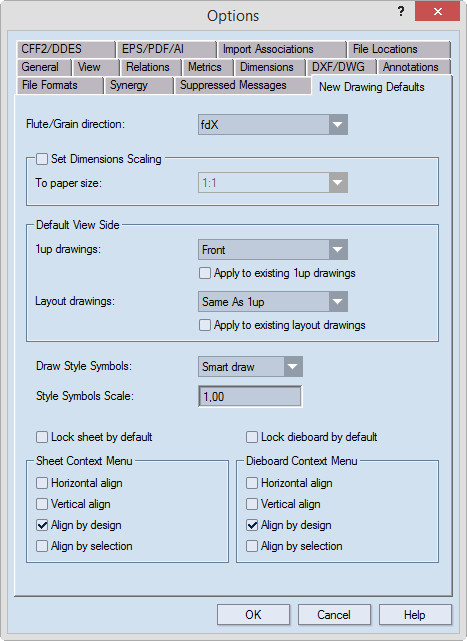In the New Drawing Defaults dialog box, settings are managed of how a new drawing will manage:

Flute/Grain direction Sets the default direction of the flute (or grain) for new drawings. NOTE: For jobs that start from a resizable design (an .evr file) or an external 3D object, the direction of the flute (grain) is predefined. For nonresizable and imported drawings, the user needs to define the direction of the flute (grain).
Set Dimensions Scaling (Not selected by default) In this group, the pattern is set for how dimensions texts, as seen on the screen, are scaled when the drawing is exported or printed out. NOTE: The defined scaling pattern affects only the drawings that will be created after OK is clicked in this dialog box. Drawings created earlier are not affected by the new setting. Regardless of the setting set here, you can set custom scaling patterns for each drawing.
To paper size In the dropdown list, select a preset scaling factor. The preset scaling factors are listed. If you need a scaling factor that is different from the listed ones, click Edit scaling options, and then, in the dialog that appears, set the scaling factor that you need.
Default View Side In this group, you tell EngView which side to display in the graphical area for 1up and layout drawings. The options: Same as 1up (layout drawings only) Front, Rear, Diecutting, Counterdiecutting. NOTE: The diecutting side is a property of the material and has been specifically defined for it. Before setting a diecutting or counterdiecutting side as a default side, check which the diecutting side is for your material, and then decide how you want to set up the default.
1up drawings Sets which side will be visible when a 1up drawing is created.
Apply to existing layout drawings When the check box is selected, the setting will apply also when earlier-created files are loaded for processing.
Layout drawings Sets which side will be visible when a layout drawing is created.
Apply to existing layout drawings When the check box is selected, the setting will apply also when earlier-created files are loaded for processing.
Draw Style Symbols Sets how style symbols will appear on the screen in newly created drawings. The options are: Smart draw The symbols appear as they were drawn if the scaling factor is 1. Example: If a style symbol was drawn 16x16 pixels and the scaling factor is 1, on the screen the style symbol will appear as 16x16 pixels. If the drawing is zoomed, the style symbols size will not change. Draw for print The symbols expand and diminish in relation with the applied zoom. This is the default setting for print drawings.
Style Symbols Scale The scale factor that the program will apply to reproduce the style symbols on the screen. Example: If a style symbol was 16x16 pixels, the scale factor 2 will increase its on-screen representation two times.
Lock sheet by default In layout projects, the sheet is locked automatically.
Lock dieboard by default In diemaking projects, the dieboard is locked automatically.
Sheet Context Menu If selected here, the following commands will appear as context-menu commands when on the screen the sheet's outer edge is right-clicked.
Horizontal align The sheet is aligned horizontally against the elements in the drawing.
Vertical align The sheet is aligned vertically against the elements in the drawing.
Align by design The sheet is aligned at once vertically and horizontally against the layout 1ups in the drawing.
Align by selection (available when one or more layout 1ups are selected) The sheet is aligned against the selected layout 1ps.
Dieboard Context Menu If selected here, the following commands will appear as context-menu commands when on the screen the dieboard's outer edge is right-clicked.
Horizontal align The sheet is aligned horizontally against the elements in the drawing.
Vertical align The sheet is aligned vertically against the elements in the drawing.
Align by design The dieboard is aligned at once vertically and horizontally against the elements in the drawing.
Align by selection (available when one or more elements in the dieboard is selected) The dieboard is aligned against the selected elements.